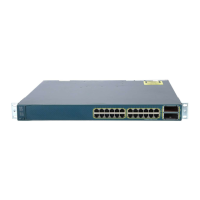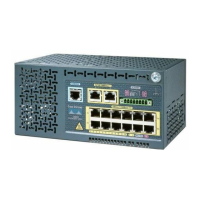23-2
Catalyst 3750 Switch Software Configuration Guide
78-16180-02
Chapter 23 Configuring IGMP Snooping and MVR
Understanding IGMP Snooping
the switch adds the host port number to the forwarding table entry; when it receives an IGMP Leave
Group message from a host, it removes the host port from the table entry. It also periodically deletes
entries if it does not receive IGMP membership reports from the multicast clients.
Note For more information on IP multicast and IGMP, refer to RFC 1112 and RFC 2236.
The multicast router (which could be a Catalyst 3750 switch with the enhanced multilayer image on the
stack master) sends out periodic general queries to all VLANs. All hosts interested in this multicast
traffic send join requests and are added to the forwarding table entry. The switch creates one entry per
VLAN in the IGMP snooping IP multicast forwarding table for each group from which it receives an
IGMP join request.
The Catalyst 3750 switch supports IP multicast group-based bridging, rather than MAC-addressed based
groups. With multicast MAC address-based groups, if an IP address being configured translates (aliases)
to a previously configured MAC address or to any reserved multicast MAC addresses (in the range
224.0.0.xxx), the command fails. Because the Catalyst 3750 switch uses IP multicast groups, there are
no address aliasing issues.
The IP multicast groups learned through IGMP snooping are dynamic. However, you can statically
configure multicast groups by using the ip igmp snooping vlan vlan-id static ip_address interface
interface-id global configuration command. If you specify group membership for a multicast group
address statically, your setting supersedes any automatic manipulation by IGMP snooping. Multicast
group membership lists can consist of both user-defined and IGMP snooping-learned settings.
If a port spanning-tree, a port group, or a VLAN ID change occurs, the IGMP snooping-learned multicast
groups from this port on the VLAN are deleted.
These sections describe characteristics of IGMP snooping on the switch and switch stack:
• IGMP Versions, page 23-2
• Joining a Multicast Group, page 23-3
• Leaving a Multicast Group, page 23-5
• Immediate Leave, page 23-5
• IGMP Report Suppression, page 23-5
• IGMP Snooping and Switch Stacks, page 23-6
IGMP Versions
The switch supports IGMP Version 1, IGMP Version 2, and IGMP Version 3. These versions are
interoperable on the switch. For example, if IGMP snooping is enabled on an IGMPv2 switch and the
switch receives an IGMPv3 report from a host, the switch can forward the IGMPv3 report to the
multicast router.
Note The switches support IGMPv3 snooping based only on the destination multicast MAC address. They do
not support snooping based on the source MAC address or on proxy reports.
